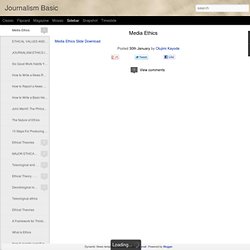

The Eatontown Sewerage Authority. INVESTIGATIVE AND INTERPRETIVE REPORTING. As the name implies, investigative reports, are those that unearth significant information about matters of public importance through the use of non-routine information gathering methods.

Most day-to-day reporting involves investigation, but true investigative stories require extraordinary expenditure of time and energy. The goal (or purpose) of investigative reporting is to present things as they are, which is not necessarily as people say they are. Investigative reporters set out to find a deeper reality, to answer questions that may never have been raised before, or at least have never been answered satisfactorily. Reporting of such depth requires the one looks at situations from the possible angle, through his own eyes, as well as those of others. It requires walking all around the subject both literally and figuratively, searching for the one perspective that shows it best.
The Transition to Digital Journalism. Beginning in the early 2000s, a new form of online social interaction emerged - social network websites.

Social networks provided people with a way to set up a personal page or profile to which they could post updates on what they were doing, while also keeping track of the activities of family, friends and colleagues. People also can engage in group activities online and display feeds of information on their home pages - everything from personal photo slideshows and videos to musical playlists and calendars to weather reports and news stories. The applications that allow social network users to display this information on their profile pages are called widgets.
Some of the early social networks were Friendster, started in 2002, and Tribe, launched in 2003. By 2008, 35 percent of adult Internet users had created a profile on a social network, quadruple the percentage in 2005, according to a Pew Internet & American Life Project survey in December 2008. Journalists and Social Networks Google+ Putting Principles Into Practice. Step-By-Step E-mail Interviewing Tips.
Jonathan Dube clearly laid out the advantages and disadvantages of interviewing sources via e-mail in his Web Tips column earlier this year.

E-mail interviews are now like telephone interviews — they have their shortcomings when stacked against the in-person interview format, but they’re also a reality for journalists under deadline pressure. Here’s a look at how to use this form of communication efficiently for reporting. Before you pose the questions, consider e-mail etiquette for reporters: E-mailing the interview questions: Whether you’re conducting a face-to-face, phone, or e-mail interview, do the same rigorous background research to prepare the questions.E-mail the questions to at least three sources that have similar backgrounds.
Once you e-mail the questions, what should you do while waiting and how long should you wait for a response? If this is a breaking news story, call your sources after an hour or two (or sooner depending on your deadline cycle). The response arrives. The Art of Journalism No. 1, Hunter S. Thompson. In an October 1957 letter to a friend who had recommended he read Ayn Rand's The Fountainhead, Hunter S.

Thompson wrote, “Although I don't feel that it's at all necessary to tell you how I feel about the principle of individuality, I know that I'm going to have to spend the rest of my life expressing it one way or another, and I think that I'll accomplish more by expressing it on the keys of a typewriter than by letting it express itself in sudden outbursts of frustrated violence. . . .” Thompson carved out his niche early. He was born in 1937, in Louisville, Kentucky, where his fiction and poetry earned him induction into the local Athenaeum Literary Association while he was still in high school. Thompson continued his literary pursuits in the United States Air Force, writing a weekly sports column for the base newspaper. His next book, Fear and Loathing: On the Campaign Trail '72, was a brutally perceptive take on the 1972 Nixon-McGovern presidential campaign. . . .
I was shocked. The Dart Center. The Dart Center for Journalism and Trauma, a project of the Columbia University Graduate School of Journalism, is dedicated to informed, innovative and ethical news reporting on violence, conflict and tragedy.

Whether the topic is street crime, family violence, natural disaster, war or human rights, effective news reporting on traumatic events demands knowledge, skill and support. The Dart Center provides journalists around the world with the resources necessary to meet this challenge, drawing on a global, interdisciplinary network of news professionals, mental health experts, educators and researchers. DartCenter.Org The Dart Center’s website provides timely articles, expert interviews, journalist-to-journalist advice, tipsheets and other resources. The website also serves as a multimedia venue for discussion of controversies and breakthroughs in trauma science, policy and media coverage.
Dart Awards for Excellence in Coverage of Trauma Ochberg Fellowships Research Journalism Education.